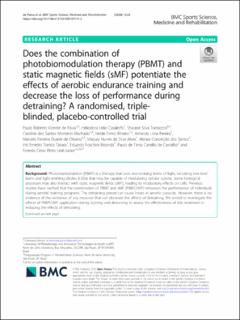| dc.contributor.author | De Paiva, Paulo Roberto Vicente | |
| dc.contributor.author | Casalechi, Heliodora Leão | |
| dc.contributor.author | Tomazoni, Shaiane Silva | |
| dc.contributor.author | MacHado, Caroline Dos Santos Monteiro | |
| dc.contributor.author | Ribeiro, Neide Firmo | |
| dc.contributor.author | Pereira, Amanda Lima | |
| dc.contributor.author | De Oliveira, Marcelo Ferreira Duarte | |
| dc.contributor.author | Alves, Marjury Nunes Da Silva | |
| dc.contributor.author | Dos Santos, Maiara Conceicąõ | |
| dc.contributor.author | Takara, Inti Ernesto Torrico | |
| dc.contributor.author | Miranda, Eduardo Foschini | |
| dc.contributor.author | de Carvalho, Paulo de Tarso Camillo | |
| dc.contributor.author | Leal, Ernesto Cesar Pinto Jr | |
| dc.date.accessioned | 2021-08-04T12:14:23Z | |
| dc.date.available | 2021-08-04T12:14:23Z | |
| dc.date.created | 2020-12-10T13:09:57Z | |
| dc.date.issued | 2020 | |
| dc.identifier.issn | 2052-1847 | |
| dc.identifier.uri | https://hdl.handle.net/11250/2766228 | |
| dc.description.abstract | Background
Photobiomodulation (PBMT) is a therapy that uses non-ionising forms of light, including low-level lasers and light-emitting diodes (LEDs) that may be capable of modulating cellular activity. Some biological processes may also interact with static magnetic fields (sMF), leading to modulatory effects on cells. Previous studies have verified that the combination of PBMT and sMF (PBMT/sMF) enhances the performance of individuals during aerobic training programs. The detraining period can cause losses in aerobic capacity. However, there is no evidence of the existence of any recourse that can decrease the effects of detraining. We aimed to investigate the effects of PBMT/sMF application during training and detraining to assess the effectiveness of this treatment in reducing the effects of detraining.
Methods
Sixty male volunteers were randomly allocated into four groups— participants who received PBMT/sMF during the training and detraining (PBMT/sMF + PBMT/sMF); participants who received PBMT/sMF during the training and a placebo in the detraining (PBMT/sMF + Placebo); participants who received a placebo during the training and PBMT/sMF in the detraining (Placebo+PBMT/sMF); and participants who received a placebo during the training and detraining (Placebo+Placebo). Participants performed treadmill training over 12 weeks (3 sessions/week), followed by 4 weeks of detraining. PBMT/sMF was applied using a 12-diode emitter (four 905 nm super-pulsed lasers, four 875 nm light-emitting diodes (LEDs), four 640 nm LEDs, and a 35 mT magnetic field) at 17 sites on each lower limb (dosage: 30 J per site). The data were analysed by two-way repeated measures analysis of variance (ANOVA, time vs experimental group) with post-hoc Bonferroni correction.
Results
The percentage of change in time until exhaustion and in maximum oxygen consumption was higher in the PBMT/sMF + PBMT/sMF group than in the Placebo+Placebo group at all time-points (p < 0.05). Moreover, the percentage of decrease in body fat at the 16th week was higher in the PBMT/sMF + PBMT/sMF group than in the Placebo+Placebo group (p < 0.05).
Conclusions
PBMT/sMF can potentiate the effects of aerobic endurance training and decrease performance loss after a 4-week detraining period. Thus, it may prove to be an important tool for both amateur and high-performance athletes as well as people undergoing rehabilitation. | en_US |
| dc.language.iso | eng | en_US |
| dc.publisher | BMC | en_US |
| dc.rights | Navngivelse 4.0 Internasjonal | * |
| dc.rights.uri | http://creativecommons.org/licenses/by/4.0/deed.no | * |
| dc.title | Does the combination of photobiomodulation therapy (PBMT) and static magnetic fields (sMF) potentiate the effects of aerobic endurance training and decrease the loss of performance during detraining? A randomised, tripleblinded, placebo-controlled trial | en_US |
| dc.type | Journal article | en_US |
| dc.type | Peer reviewed | en_US |
| dc.description.version | publishedVersion | en_US |
| dc.rights.holder | Copyright The Author(s). 2020 | en_US |
| dc.source.articlenumber | 23 | en_US |
| cristin.ispublished | true | |
| cristin.fulltext | original | |
| cristin.qualitycode | 1 | |
| dc.identifier.doi | 10.1186/s13102-020-00171-2 | |
| dc.identifier.cristin | 1858277 | |
| dc.source.journal | BMC Sports Science, Medicine and Rehabilitation | en_US |
| dc.identifier.citation | BMC Sports Science, Medicine and Rehabilitation. 2020, 12, 23. | en_US |
| dc.source.volume | 12 | en_US |

